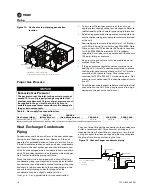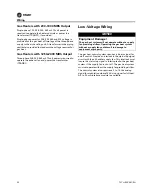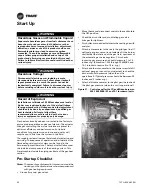
Start Up
CLCH-SVX08C-EN
27
Unit Operation
1. Remove any debris from combustion air inlets and/or
hoods. Note that some combustion air inlets are
located on the floor panel of the piping vestibule.
Insure the openings are not blocked. (If it is an outdoor
unit, make sure the flue was removed from inside the
unit and is installed properly.)
2. Connect the interlock with the air handling supply fan
terminals in the gas heat terminal box with the air
handling control system. If jumpers are used in the gas
heat control panel to set up unit, ensure they are
removed and the correct air handling control system is
connected.
3. Measure the gas pressure at the tee in the pilot gas line
(inlet gas pressure). The inlet gas pressure should not
exceed 14 in. w.g. Adjust the gas pressure, if necessary.
4. Open the first manual gas valve (inlet) in the burner
vestibule.
5. Open the manual gas valve in the pilot gas line and
bleed the air from the line. (Do not open the second
manual gas valve to the manifold.)
6. Move the manual disconnect switch in the heater
vestibule to the ON position.
7. If the building control system is calling for heat, the
system should energize. If jumpers are used in the gas
heat control panel to close between terminals for
startup, ensure they are removed and unit controls
controlling the “call for Heat” are attached properly
after startup.
8. The unit control system should energize supply fan in
less than 60 seconds after call for heat signal is given
(if not already running). Ensure supply fan airflow is
made before safety circuitry de-energized burner
assembly. The following safety/limit contracts should
be closed:
•
HLl1: high-temperature limit
•
Al1: airflow interlock (air handling fan should
either be running or started 60 seconds after call
for heat)
•
HPGS1: high-pressure gas switch
•
LPGS1: low-pressure gas switch
Pre-Purge and Pilot Ignition
(3:1, 10:1 Turndown, 200-2000 MBh)
1. The burner will be going through a purge sequence.
The combustion air blower should run for
approximately 90 seconds to evacuate the heat
exchanger of any combustible gases before the
ignition sequence. This pre-purge cycle is initiated
before every startup.
2. With the pre-purge cycle complete, the ignition
transformer and pilot solenoid should be energized,
allowing gas to flow to the pilot burner. The pilot
should light immediately. The pilot flame gas pressure
should be 2.5 inches w.g.
3. If the pilot does not light within 10 seconds, the flame
relay/rod should shut down the system. If the pilot
does not light, press the Reset button to clear the fault
and repeat the procedure outline in the startup.
4. Cycle the pilot on and off several times to ensure its
reliability.
5. Turn the manual disconnect switch in the gas heat
control panel to the Off position and proceed to the
Main Burner Ignition.
Figure 22. Control panel for the FDM burner on 1250-
2400 MBh (20:1 turndown) units
WARNING
Live Electrical Components!
During installation, testing, servicing and
troubleshooting of this product, it may be necessary to
work with live electrical components. Have a qualified
licensed electrician or other individual who has been
properly trained in handling live electrical components
perform these tasks. Failure to follow all electrical
safety precautions when exposed to live electrical
components could result in death or serious injury.
Содержание K01K12345
Страница 21: ...Wiring CLCH SVX08C EN 21 Figure 16 Natural gas 200 320 MBh 10 1 turndown...
Страница 22: ...Wiring 22 CLCH SVX08C EN Figure 17 Natural gas 360 1000 MBh 3 1 and 10 1 turndown and propane 200 1000 MBh...
Страница 23: ...Wiring CLCH SVX08C EN 23 Figure 18 Single phase natural gas and propane 1250 2000 MBh 3 1 and 10 1 turndown...
Страница 25: ...Wiring CLCH SVX08C EN 25 Figure 20 Natural gas and propane1250 2400 MBh 20 1 turndown...
Страница 34: ......
Страница 35: ......





































